#Source: Super Dictionary
Explore tagged Tumblr posts
Text
When no one was looking, Milo Kamalani ate forty fish sticks. He ate 40 fish sticks.
That's as many as four tens.
And that's terrible.
3 notes
·
View notes
Text
T.J.: Did you hurt yourself? Did you hurt your own body? Can you get home by yourself? Can you get home alone? Gus: Please help me.
2 notes
·
View notes
Text
Vocabulary (geirfa)
Coelio -> to believe (verb)
coelion -> belief (noun)
Wnaeth y cyflwynedd, actores a cantores Lisa Jên bostio ar Twitter am rywbeth ei bod hi dweud dyw hi ddim yn gallu ‘coelio’n lwc’, or that she couldn’t believe her luck. Learned a new word today!
‘Methu coelio’n lwc!’ Can’t believe our luck!
Note: ‘n here. I’d assume it was short for ‘ein’? Our luck?
‘Wnes i ddim yn gallu coelio fy lwc pan wnes i ddod o hyd iddi hi. Ro’n i wedi bod ei chwylio amdani hi am hir!’ I couldn’t believe my luck when I found her. I had been searching for her for ages!
‘Doedd fy nghoelion ddim wedi cael torri.’ My belief was not shattered. (Idk, dramatic sentence. Couldn’t think of much else to use belief in really)
Another word for believe is ‘credu’, though I don’t know if you can use the two in interchangeable ways.
‘Dw i ddim un credu bod neb wedi ei weud e wrthi hi.’ I don’t believe that anyone has told her [about it].
#Not tagging this any of the learner tags bc each and every one of those sentences could be exquisitely wrong#vocabulary#sentences#source: dictionary#source: online#Source: twitter#Lisa Jên was in the folk indie rock band 9Bach!#Also if you’re a Super Furries fan you may also remember her from doing the backing vocals on Gruff Rhys’ song Candylion#She won a Welsh BAFTA recently for a documentary on the Welsh language: Stori’r Iaeth!
8 notes
·
View notes
Text
When no one was looking, Dr. Blakk took forty cakes. He took 40 cakes. That’s as many as four tens. And that’s terrible.
Kord
#source: the super dictionary#slugterra#incorrect quotes#incorrect slugterra quotes#kord#kord zane#dr. blakk#dr. thaddius blakk#thaddius blakk#mine
11 notes
·
View notes
Text

#Superman#Lois lane#dc comics#dc memes#screenshotted memes#credit to casually comics#YouTube screenshots#source: casually comics#clearing out phone#clearing out camera roll#phone dump#the super dictionary#pre-crisis dc
7 notes
·
View notes
Text
i do think that a lot of ppl underestimate the skill/knowledge it takes to make ai art. like if u wanna goof off and make something simple its not that hard but if u have a vry specific thing in ur head u want to make u need to have a deeper understanding of whatever ur using
#like its not hard to get good looking stuff with simple prompts. especially with things like midjourney but if u want something super#specific and detail u basically need to have the entire dictionary memorized and some more#also yeah. coding is cool. i remember seeing some cool stuff being developed with the og stable diffusion source code
0 notes
Text
Interior Department Announces New Guidance to Honor and Elevate Hawaiian Language

"In commemoration of Mahina ʻŌlelo Hawaiʻi, or Hawaiian Language Month, and in recognition of its unique relationship with the Native Hawaiian Community, the Department of the Interior today announced new guidance on the use of the Hawaiian language.
A comprehensive new Departmental Manual chapter underscores the Department’s commitment to further integrating Indigenous Knowledge and cultural practices into conservation stewardship.
“Prioritizing the preservation of the Hawaiian language and culture and elevating Indigenous Knowledge is central to the Biden-Harris administration's work to meet the unique needs of the Native Hawaiian Community,” said Secretary Deb Haaland. “As we deploy historic resources to Hawaiʻi from President Biden’s Investing in America agenda, the Interior Department is committed to ensuring our internal policies and communications use accurate language and data."
Department bureaus and offices that engage in communication with the Native Hawaiian Community or produce documentation addressing places, resources, actions or interests in Hawaiʻi will use the new guidance on ‘ōlelo Hawaiʻi (Hawaiian language) for various identifications and references, including flora and fauna, cultural sites, geographic place names, and government units within the state. The guidance recognizes the evolving nature of ‘ōlelo Hawaiʻi and acknowledges the absence of a single authoritative source. While the Hawaiian Dictionary (Pukui & Elbert 2003) is designated as the baseline standard for non-geographic words and place names, Department bureaus and offices are encouraged to consult other standard works, as well as the Board on Geographic Names database.
Developed collaboratively and informed by ʻōlelo Hawaiʻi practitioners, instructors and advocates, the new guidance emerged from virtual consultation sessions and public comment in 2023 with the Native Hawaiian Community.
The new guidance aligns with the Biden-Harris administration’s commitment to strengthening relationships with the Native Hawaiian Community through efforts such as the Kapapahuliau Climate Resilience Program and Hawaiian Forest Bird Keystone Initiative. During her trip to Hawaiʻi in June, Secretary Haaland emphasized recognizing and including Indigenous Knowledge, promoting co-stewardship, protecting sacred sites, and recommitting to meaningful and robust consultation with the Native Hawaiian Community."
-via US Department of the Interior press release, February 1, 2024
--
Note: I'm an editor so I have no idea whether this comes off like as big a deal as it potentially is. But it is potentially going to establish and massively accelerate the adoption of correctly written Native Hawaiian language, as determined by Native Hawaiians.
Basically US government communications, documentations, and "style guides" (sets of rules to follow about how to write/format/publish something, etc.) can be incredibly influential, especially for topics where there isn't much other official guidance. This rule means that all government documents that mention Hawai'i, places in Hawai'i, Hawaiian plants and animals, etc. will have to be written the way Native Hawaiians say it should be written, and the correct way of writing Hawaiian conveys a lot more information about how the words are pronounced, too, which could spread correct pronunciations more widely.
It also means that, as far as the US government is concerned, this is The Correct Way to Write the Hawaiian Language. Which, as an editor who just read the guidance document, is super important. That's because you need the 'okina (' in words) and kahakō in order to tell apart sizeable sets of different words, because Hawaiian uses so many fewer consonants, they need more of other types of different sounds.
And the US government official policy on how to write Hawaiian is exactly what editors, publishers, newspapers, and magazines are going to look at, sooner or later, because it's what style guides are looking at. Style guides are the official various sets of rules that books/publications follow; they're also incredibly detailed - the one used for almost all book publishing, for example, the Chicago Manual of Style (CMoS), is over a thousand pages long.
One of the things that CMoS does is tell you the basic rules of and what specialist further sources they think you should use for writing different languages. They have a whole chapter dedicated to this. It's not that impressive on non-European languages yet, but we're due for a new edition (the 18th) of CMoS in the next oh two to four years, probably? Actually numbering wise they'd be due for one this year, except presumably they would've announced it by now if that was the case.
I'm expecting one of the biggest revisions to the 18th edition to add much more comprehensive guidance on non-Western languages. Considering how far we've come since 2017, when the last one was released, I'll be judging the shit out of them if they do otherwise. (And CMoS actually keep with the times decently enough.)
Which means, as long as there's at least a year or two for these new rules/spellings/orthographies to establish themselves before the next edition comes out, it's likely that just about every (legit) publisher will start using the new rules/spellings/orthographies.
And of course, it would expand much further from there.
#don't ask me about the magazine and newspaper half of this#bc I do Not know AP style#except the differences I'm annoyed at lol#ap doesn't respect the oxford comma#hawaii#hawaiʻi#language#orthography#linguistics#language stuff#hawaiian#native hawaiian#united states#publishing#book publishing#indigenous#indigineous people#indigenous languages#language revitalization#language resources#editorial
413 notes
·
View notes
Note
Hi Slug! If possible could you please translate the new updated timeline from the second guidebook? Thank you so much 🙏
I typically don't want to translate any sort of paid content, but I'll make an exception just this once so we can publicly shame Hypmic for its ludicrous timeline have this as a resource.
The guidebook's timeline is split into two halves corresponding to Chuuouku and the six Divisions featured in the storyline. For ease of reading, I've combined them into one and placed them in order (as much as possible).
The translation is as direct as possible. I do not translate word by word by the dictionary when there are more straightforward or natural-sounding equivalents available, and I do not incorporate features of the source grammar and punctuation that are nonsensical in English. Apart from that, this is super cut-and-dry. It's a timeline lol.
Finally, a note about the "H Age" (H歴) year system: While treated as its own calendar system similar to BCE and CE (or BC/AD), the H Age notation is otherwise similar to Japanese "eras." In real life, a new era corresponds to a new emperor taking the throne, so Otome's rise to power and the subsequent beginning of the H Age marks a paradigm shift. Eras can start in the middle of a calendar year, so Year 1 of the H Age isn't necessarily from January to December (in so much as Hypmic has months anyway). Let's arbitrarily say it started in June 2024. (Did it? No idea. I made this up for argument's sake.) That means Year 1 is June - December of 2024 while "one year prior" is January - May also of 2024. Therefore, "two years prior" is January - December of 2023. And so on and so forth.
Under a cut for length
19 years prior to the H Age
Rei joins a military R&D program.
Otome founds the Party of Words.
13 years prior to the H Age
World War III begins.
11 years prior to the H Age
World War III ends, but smaller violent conflicts continue.
Rei leaves the military and assembles an independent Hypnosis Mic development team.
4 years prior to the H Age
Rei creates a working Hypnosis Mic.
3 years prior to the H Age
Otome purchases the Hypnosis Mics from Rei.
The military creates a working Hypnosis Mic prototype.
Rei begins development of the Hypnosis Canceler.
2 years prior to the H Age
Rei creates a working True Hypnosis Mic.
1 year prior to the H Age
The Party of Words stages a coup d'tat.
Rei creates a working Hypnosis Canceler and gives the first Ramuda to Otome.
Year 1 of the H Age
The H Age begins, ending violent conflict with weapons.
The Party of Words overwhelms the preexisting government, thus subverting the state.
The Party of Words founds Chuuouku and distributes Hypnosis Mics to select candidates.
Ichirou and Kuukou form Naughty Busters.
Samatoki and Sasara form Mad Comic Dialogue.
Ramuda meets Jakurai and Yotsutsuji. The former two go on to form Kuujaku Posse.
Otome purchases the True Hypnosis Mic from Rei.
Ichirou and Kuukou begin working with Mad Comic Dialogue.
Year 2 of the H Age
Ramuda clones use the True Hypnosis Mic to brainwash Sasara and Kuukou. Kuukou tells Ichirou their friendship is over and leaves for Nagoya. Sasara does the same and returns to Osaka.
Ichirou, Samatoki, Ramuda, and Jakurai form The Dirty Dawg.
The Dirty Dawg gains supremacy over every Division in Japan. A Ramuda clone puts Yotsutsuji in a brainwashing-induced coma.
A Ramuda clone brainwashes Nemu. She goes on to join the Party of Words.
Ichirou and Samatoki battle one another in accordance with a Chuuouku plot. At the same time, Jakurai and Ramuda fight over the Yotsutsuji situation. This leads to The Dirty Dawg disbanding.
The Party of Words disables all preexisting Hypnosis Mics distributed [through their program in Year 1] and recalls the mics.
The Party of Words creates the Division Rap Battle program.
Year 3 of the H Age
Ichirou, Samatoki, Ramuda, and Jakurai receive mics from Chuuouku.
The Division Rap Battle program begins.
Ichirou forms the Buster Bros with Jirou and Saburou.
Samatoki forms Mad Trigger Crew with Juuto and Riou.
Jakurai forms Matenrou with Hifumi and Doppo.
Ramuda forms Fling Posse with Gentarou and Dice.
Preliminary matches begin within each Division. The Buster Bros, Mad Trigger Crew, Fling Posse, and Matenrou win their respective preliminaries, thus advancing to the finals.
Ichijiku uses a Hypnosis Canceler for the first time.
In the first DRB tournament, Mad Trigger Crew wins round 1 against the Buster Bros.
In the first DRB tournament, Matenrou wins round 2 against Fling Posse.
In the first DRB tournament, Matenrou wins the final match against Mad Trigger Crew and takes the championship.
Hitaki Tsumabira, Vice Director General of the Criminal Bureau, and the Tobari brothers attempt to lay a trap for the Buster Bros, Mad Trigger Crew, Fling Posse, and Matenrou. Their plot fails.
Ichijiku has Tsumabira purged from the Party of Words for using the Tobari brothers to traffic the Grasshopper drug.
The Party of Words announces the second DRB.
Kuukou and Sasara receive mics from Chuuouku.
Rei meets Sasara and Roshou. The three go on to form Dotsuitare Hompo.
Hitoya introduces Juushi to Kuukou, who takes Juushi under his wing as an apprentice. The three go on to form Bad Ass Temple.
Ichirou notices Nemu's name on a list of missing persons and meets up with Sasara and Roshou to find out more. Rei meets with Jirou and Saburou. He reveals that he is their father and that Ichirou has been lying to them.
Nemu becomes the Vice Director General of the Administrative Inspection Bureau.
Nemu, still brainwashed, shows up in front of Samatoki with other Chuuouku members. Ramuda confesses to Samatoki that he brainwashed her.
Gentarou and Dice learn that Ramuda is a clone.
Chuuouku approaches Jakurai for his crucial assistance in improving the True Hypnosis Mic in order to bring Yotsutsuji out of his coma. Jakurai and Hitoya reunite. Meanwhile, Hifumi and Doppo meet Kuukou and Juushi.
Chuuouku decides to have Ramuda killed. Honobono enlists the Word Wreckers to join her in hunting him down. Gentarou and Dice come to his rescue and spirit him away to safety, but now all three are wanted as outlaws.
Dice performs a trade with Otome, giving her the Chuuouku expose left behind by Gentarou's older brother. Ramuda is allowed to go free, and Fling Posse is granted permission to participate in the second DRB.
Jakurai agrees to cooperate with Chuuouku under certain conditions. Honobono pays a visit to Hifumi's club.
Juuto arrests Sekirei Hanmyou, the man responsible for the drug that led to Juuto's friend and parents' deaths.
Nemu arrests Tsumabira, now escaped from prison, and her coconspirator in crime Misago Haebaru. Honobono rises to position of Vice Director General of the Criminal Bureau in Tsumabira's place.
Ichirou battles Jirou while Saburou battles Rei. The brothers make up afterward.
After receiving advice from Rei, Sasara and Roshou battle one another and come clean about their feelings. With that bad blood washed away, the team comes together stronger than ever.
Juushi comes face to face with the boy who bullied him and took his grandmother's life. Through his own fortitude, Juushi prevails through the mental distress. After talking with Kuukou, Hitoya lets go of the past in seeking revenge for the death of his brother. The team comes together stronger than ever.
The second DRB preliminaries come to an end. The Buster Bros, Mad Trigger Crew, Fling Posse, Matenrou, Dotsuitare Hompo, and Bad Ass Temple advance to the finals.
In the second DRB tournament, the Buster Bros win round 1 against Dotsuitare Hompo.
In the second DRB tournament, Matenrou wins round 2 against Bad Ass Temple.
In the second DRB tournament, Fling Posse wins round 3 against Mad Trigger Crew.
In the second DRB tournament, Fling Posse wins the final match against the Buster Bros and Matenrou, thus claiming the championship.
Sasara and Kuukou learn that they were brainwashed. Ramuda opens up to Jakurai and tells him the truth. Ichirou and Samatoki learn the truth as well, thereby resolving the feuds between the team leaders.
The Party of Words announces the third DRB.
The Party of Words locates and seizes control of Rei's laboratory. In an exchange of hostages, the Party gains control of the True Hypnosis Mic and Ramuda clones.
Otome announces plans for world domination before Rei attempts a coup d'tat. All Hypnosis Mics are disabled, and Otome and Ichijiku are sent to maximum security prison by the very Ramuda clones Rei created.
Public order breaks down following the disabling of the mics.
Ichirou discovers Rei's connection to the Hypnosis Mics due to Gentarou's brother's expose. The main cast, led by Jirou and Saburou, hold a music festival to bring courage to everyone struggling with the political turmoil.
Honobono frees the inmates of Chuuouku's maximum security prison. After staging an attack on the music festival, she disappears from the eye of Chuuouku.
Rei and Ichirou have a fistfight over their respective moral positions. Rei acknowledges his defeat, reconsiders his moral stance, and reactivates all Hypnosis Mics.
Armed with a working mic once more, Nemu takes command and restores order within Chuuouku. Otome decides to step down from her position in government.
152 notes
·
View notes
Text
OK, I was going to reblog this excellent post by @luckshiptoshore so go read it, because yes. Yes!! YES!!! But then when I got started my post got super long and I felt bad tacking it onto her post and decided to make my own in response to these tags:
#i am actually a bit obsessed by the whole hunting as queerness metaphor#it’s so clearly something everyone involved in the show is thinking about#supernatural
Gurl, me too! Like go back to the start! By the time Supernatural began, the backlash against the Joseph Campbell Monomyth-style mode of storytelling had already begun in the hallowed halls of USC film school, and yo: I was there at the time of Kripke's graduation, and my best friends from college are full scale big giant time filmmakers now, whose names I will not share on main because it's uncool, and I don't want that attention, but... yeah. I am referencing FIRST HAND SOURCES on this.
But, for a real source? The Oxford English Dictionary places the first use of the term "Queer Theory" in 1990, with Queer Studies as an option in the academy by 1992. I know the kids think it's a new-fangled thing, but Kripke graduated USC in 1996 (I graduated in 1995) and it was ALL THE RAGE by then. My friends read queer theory in their Critical Studies courses in the Film School, I read it in the College of Humanities getting my degree in Literature. By that time, you could not get through that school with any degree in any non-STEM subject without knowing about ye olde postmodern lenses, queer and feminist theory, and without knowing how to employ those lenses.
Queer refers to sexuality, yes, but the word's earliest use (again, according to the OED) is in the 1500's, meaning: strange, odd, peculiar, eccentric. Also: of questionable character; suspicious, dubious.
So, ok, in 2005, Enter Supernatural, episode 1:
Presented? Two brothers. One actively seeking credit in the straight world that is not available to him in the bosom of his family: Stanford, law school, hot co-ed girlfriend, the other bound to his fractured, wounded family by duty, yes, but also by love, living on the fringe, alone, fighting monsters, and chasing after his father's approval, and who has long since given up any dream of being 'normal'. Episode 1 presents Sam's call to adventure, which he refuses when it's just familial duty, honor and love calling him, but accepts when the show takes a very straightforward and very telling path by classically fridging his woman. Ok, now he's on board. Like John, whose motivation is another dead woman, his motivation is revenge. So far so straight!
Dean though: he's different. He is already on the adventure and he was not 'called' or given the option of accepting or refusing because he had no agency when his feet were set upon this road. He does not fit the straight world at all, because he is cobbled together out of love, duty, deep guilt, striving, desperation and fear. This is who he is now, in some elemental, incontrovertible way. It was not a choice for him, he was born to it. His mother is dead, and we later learn, she made the choices that brought them all to this fate. Dean remembers her idyllically, but he is not motivated by revenge, more than any other thing, he wants to be worthy. He wants his father's approval, his brother's love.
Enter Supernatural's main theme: fucked up relationships between men enmeshed in patriarchy, which will eventually expand to include fucking GOD HIMSELF.
And like, there are SO MANY CLEAR STEPS ALONG THE ROAD in season one, and I am not even talking about sexuality and gender here, but there is SO MUCH TO SAY about it in season 1. But I am not talking about that -- I am talking at a structural, narrative level, the whole thing is just fucking all the way queered, yo.
The big climax?
At the end of the season, Dean says: "I just want my family back together. You, me, Dad... it's all I have." He is Sam's mother, John's partner! His vulnerability and emotion is feminized and contrasted with Sam and John's more overtly driven by their more masculine/straight heroic revenge quest. John: "Sam and I can get pretty obsessed, but you always take care of this family." Only that's not John talking, it's Azazel, and Dean knows it is because his father would never forgive how soft he is, how he will always choose love and family over revenge. Then, in the end, the show makes a huge point of telegraphing that Sam is finally aligning with Dean by refusing to shoot Azazel because he's possessing John, and Sam just can't do that to Dean.
Sam and Dean are thus bound together and cemented into a marginalised path, living on the road, haunting liminal spaces and cheap motels, confronting the monstrous everyday. Sam is presented as the brains of the operation, he does research, logics his way through things (masculine) while Dean is the heart who acts impulsively and on instinct and intuition (feminine).
It later transpires that Sam has a piece of the monster inside himself, and Dean has to learn to love the monstrous, he has no choice, because Sam is his brother and then Cas... and, and, and!
Like... I could go on and on, citing ENDLESS EXAMPLES. This could be a literal book. Maybe one you need to read with a magnifying glass like my condensed edition of the OED. LIke, the queerness of Supernatural is DIZZYING and MYRIAD.
But basically? FROM THE START, hunting is a queered version of family, and within that, Dean is a queered version of a Campbellian hero. Hunting is a metaphor for otherness and liminality, and that's even before you say a WORD about sex. It starts in deviation from the norms of family, masculinity and expands from there on so many levels both in story and on a meta level. The story is flesh on queer fucking bones.
I'm so sorry, but anyone who thinks queerness was not BAKED INTO Supernatural and more specifically into Dean from DAY 1 has clearly never seen Dean's insane lip gloss in season 1, and vastly underestimates the cultural awareness of people who write shit in Hollywood, and also the other people who put pink lip gloss on pretty boys in Hollywood. Nothing that gets on your screen wasn't a fucking choice made and approved by a LONG LIST of people who know what they are about.
#supernatural#dean winchester#sam winchester#the queerness is baked in from the word go#like...OBVIOUSLY#and transparently
167 notes
·
View notes
Text
SK8 Cast Image Colors, and the Super Sentai Roots of Character Color Coding
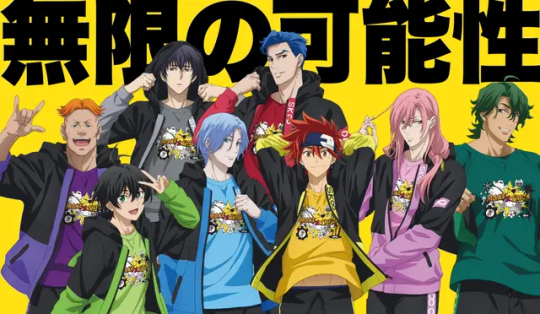
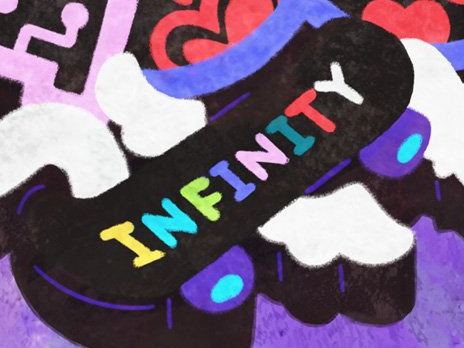
Unlike my post about hanakotoba, where only a few examples can be confirmed to be intentionally meaningful choices, image colors are an aspect of SK8's visual symbolism that has been explicitly assigned by the creators to each of the eight main cast members. From design elements to official art and merchandise (such as the art and the Infinity Week logo above) to shots in the show itself, these image colors are a consistent aspect of the series' visual language, and colors, like flowers, have meanings and associations that can provide interesting insight into why these colors were chosen for these characters. Color-coded casts are also strongly historically rooted in the super sentai subgenre of tokusatsu series, a genre that has had massive impact on Japanese pop culture, especially battle anime like SK8, in part, is, so I'll also examine the archetypes associated with their colors in super sentai (and, in Adam's case, another important piece of anime history.)
As color associations can vary by culture, I made sure to use Japanese sources - I mainly started with the dictionary on TC Color Therapy for basic color meanings but frequently checked other sources. My primary source on colors in super sentai is a paper on color theory in tokusatsu by Misako Takahashi, along with fan wikis such as Pixiv Dictionary and other Japanese blogs analyzing the subject. I also supplemented with quotes from SK8's staff when relevant.
All the image colors come from the official character guide included in volume 4 of the Blu-rays.
Reki Kyan - Yellow
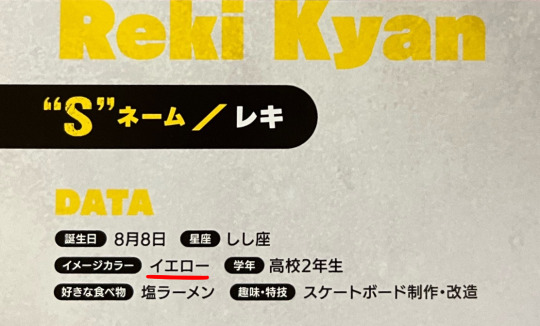
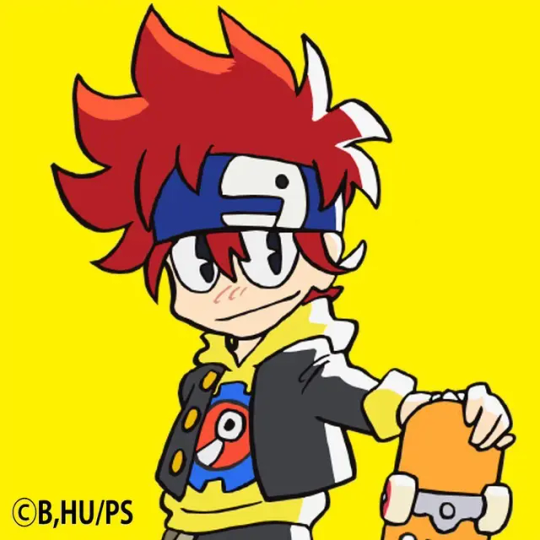
Despite his red hair, Reki's image color is yellow, the color of the signature hoodie he always wears at S. Yellow is associated with brightness, cheerfulness, fun and excitement - all things that Reki embodies at his best, and are very important parts of his character arc and what he represents to the people around him. In Utsumi's instructions to colorist Yukari Gotou, as shown in SK8 Design Works, she requested Reki's design have "so many bright and colorful primary colors it's tiring" in order to draw the eye, fitting of a bright and energetic protagonist. Yellow is a common color for team members in sentai anime, being the third most common after red and blue and appearing in the majority of series, and are often bright and cheerful "life of the party" type characters as well. This is a trend dating back to Himitsu Sentai Gorenger, the very first long-running super sentai series (beginning in 1975,) whose color coding has persisted for decades. Kirenger, the yellow member in Gorenger, was even a big eater with a signature favorite food (a trait more commonly attributed to Langa, but Reki's love for ramen and all things salty - even toothpaste - is a recurring bit in SK8 as well) and a big family.
In Takahashi's paper, she quotes another academic, Asako Yoshida's, analysis of another core aspect of yellow sentai characters, where she describes them as "an intelligent type who gathers information and forms strategies before taking action", and "rather than fighting on the front, they're a tactician who uses their wits and comes up with strategies," traits that Reki also shows frequently, especially in his biggest triumph in episode 11.
Like many of the image colors, it's also used in the show (both in the opening - highlighting his yellow-orange eyes - and in episode 11.)

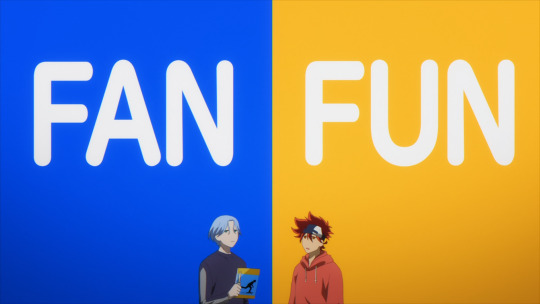
~
Langa Hasegawa - Blue
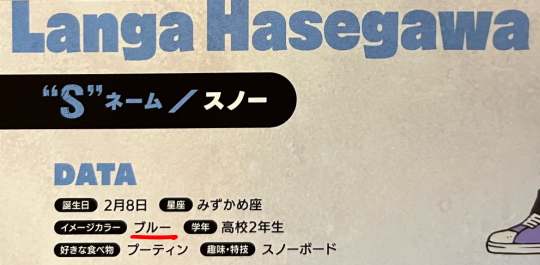
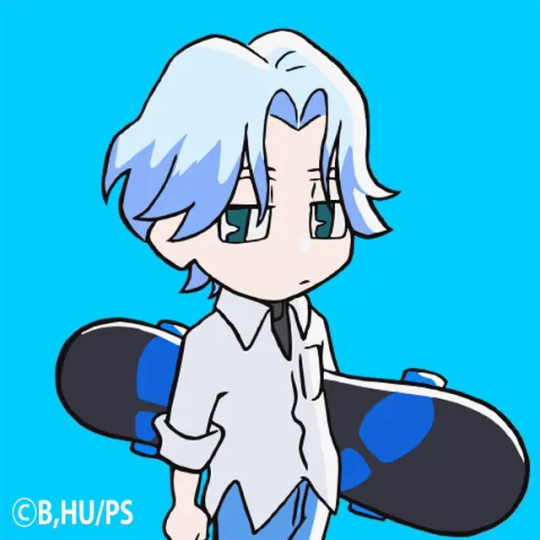
Langa's image color is blue, selected along with white from the beginning to fit his snow theme. Blue is associated with positive meanings like calmness and intelligence, but also more negative ones like coldness, sadness and loneliness, fitting of both Langa's calm exterior and the grief that's central to his storyline. Blue sentai members are classically considered "cool" characters, an association that remains strong even as actual characters of that type have grown somewhat rarer over time, with newer series sometimes deliberately subverting expectations. Like yellow, the association of blue with the cool member of a team also dates back to Gorenger, with Aorenger (the blue member) being a cool, stoic character who came from a snowy region. Takahashi quotes Yoshida's description of blue heroes as "the calm, composed and cool second in command type," a character who "doesn't worry about what's in front of him, never seems to get worked up and deals with things calmly," which certainly describes the impression Langa gives off at first - and belies what SK8's producer Kyoko Uryuu described (when comparing him to a petit gâteau) as his "surprisingly passionate" interior.
Like with Reki, Langa's color is shown off in the opening and in the show itself - notably as his "aura" when he's in the Zone with Adam.
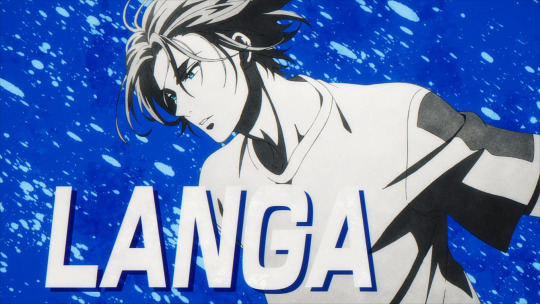
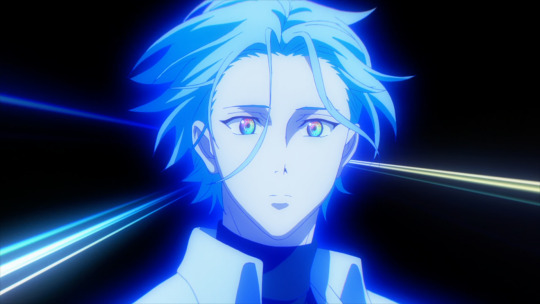
~
Miya Chinen - Light Green
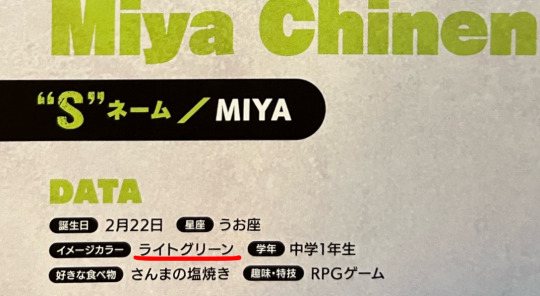
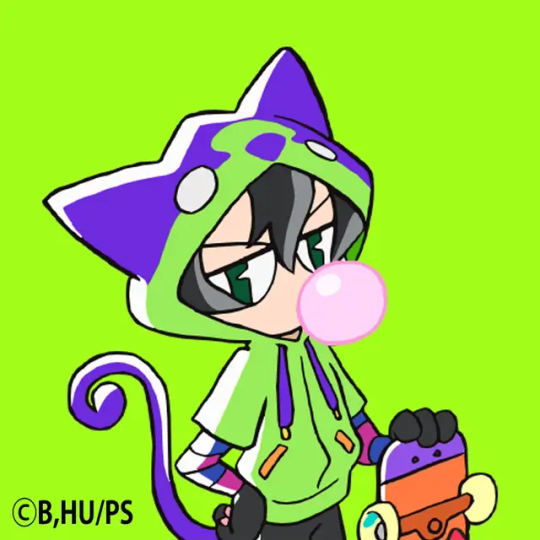
Miya's image color is light green, usually shown as a yellowish lime green. I'll get to green as a whole for Kojiro, but yellow-green specifically is associated with youthfulness, beginnings and hope, as it's the color of newly budding plants - and it can also be associated with immaturity, all meanings fitting of a very young character like Miya. While his costume is meant to be an in-universe game character, his bright green hood could also be seen as vaguely evoking Link from the Legend of Zelda series.
Green sentai characters have more varied archetypes, but were historically often the youngest member of the team, while more recently it's been a trend for them to be the oldest member of the team - fitting for the youngest and oldest members of the six characters making up SK8's main "team." The idea of a green member being the youngest also dates back to Gorenger, with Midorenger (the green member) being an innocent younger boy compared to the rest of the team, who was treated like a "mascot" of sorts and even shared Miya's affinity for animals. It's also become a trend for green characters to have close relationships with the yellow members, and to be in conflict with the red members.
Like with most of the other characters, Miya's color is highlighted in the opening.
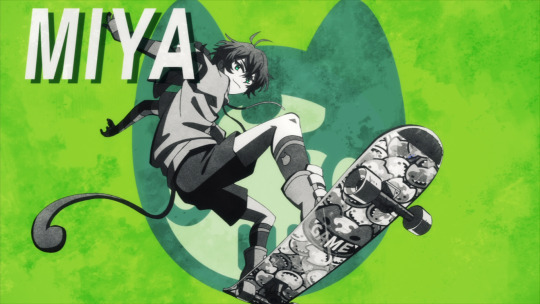
~
Hiromi Higa - Purple
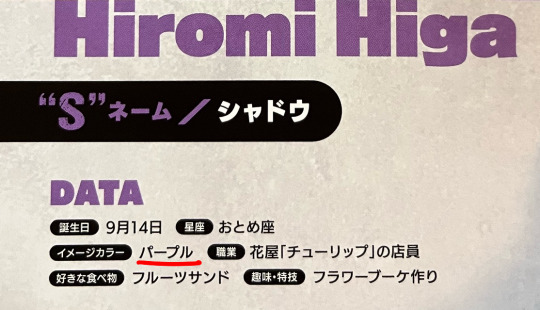
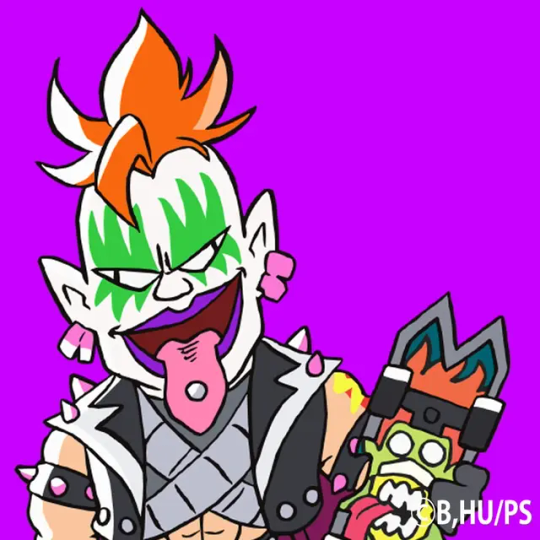
Hiromi's image color is purple, the color of his lipstick and the inside of his cape. Purple is associated with mystery, rarity, luxury and nobility, and in Japan in particular it's frequently associated with horror (from urban legends like the purple mirror to the common use of purple miasma to show disgusting/horrific food in anime.) Purple sentai members are incredibly rare, and at the time of Takahashi's paper the few that existed were usually mentor figures, but several since have been "dark heroes" or antiheroes - as "Shadow-sama" (fitting of the link to nobility) calls himself, as the self-proclaimed Antihero of the S community. With how he becomes a close friend (and even somewhat of a mentor) to the boys despite his very antagonistic first appearance, he certainly fits the "enemy-turned-ally" archetype, and while he's not actually the much older mentor early purple members were, Reki constantly calling him "old man" does evoke that trope too.
His color appears in the opening as well as featuring heavily in his S costume.
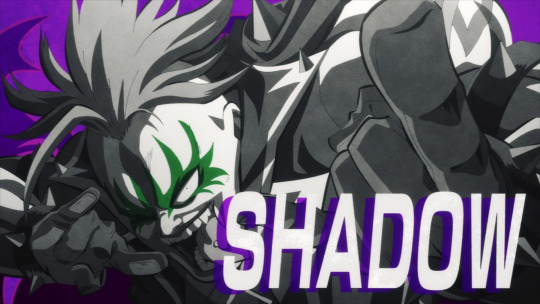
~
Kaoru Sakurayashiki - Pink
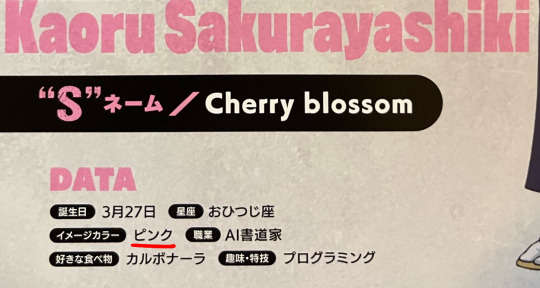

True to his surname and aesthetic, Kaoru's image color is pink, the color of cherry blossoms. Pink is associated with beauty, grace, luxury and love. Just like in the west, it's considered a very feminine color - also shown in the fact that pink sentai members are almost exclusively women, and typically particularly feminine and glamorous when on teams with other female members. This is a case where Cherry is in large part a departure from the classic color coding just because of his gender; SK8's colorist, Yukari Gotou, even expressed in Skater's Backstage that she was a bit worried about having a male character with pink hair, but Utsumi described him as a "pink ninja" from the get-go in her coloring notes.
And even Kaoru isn't completely immune to hitting the sentai archetypes either, with his noted beauty and a concern for his looks that Kojiro mocks as effeminate in the series; the contrast between the feminine characteristics he has and his masculine voice and personality are a core part of how his character was designed. He even has a surprising connection with Momorenger (Gorenger's pink member, and only woman) in his affinity for kicks. (As of 2022, there's also finally been a male character properly featuring as the pink member in a sentai series in Avataro Sentai Donbrothers.)
Of course, on top of featuring so heavily in his design, Cherry's color is also used in the opening.
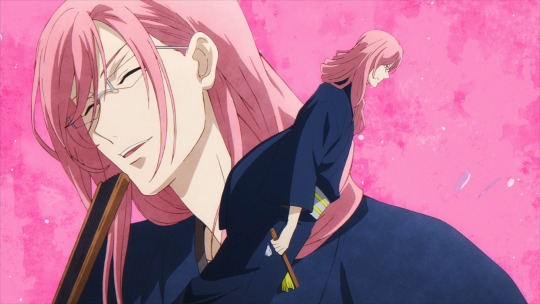
~
Kojiro Nanjo - Green
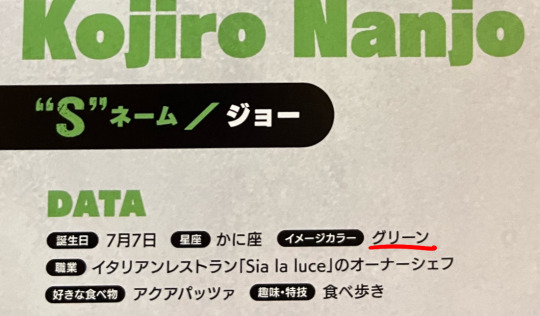

Rather than Miya's light green, Kojiro's image color is a regular green. Green is associated with calmness, stability, growth and nature, fitting for a very calming and stable mentor character who just "goes with his feelings" like Kojiro - but like light green, it can also signify immaturity, which also suits a character who proudly proclaims to be a "kid" when he's on vacation. Where Miya fits the "youngest member" trope for green sentai members, Kojiro fits the "oldest member" trope, and he also fits the recently trendy close relationship with yellow and conflict with red. In Takahashi's paper, she quotes Yoshida describing green characters as a whole as "a caring type who's always concerned if things are peaceful" (also fitting of Miya, who's always the most concerned for Reki and Langa,) "a soothing person who makes you feel warm and comforted just by being next to them" and as someone who "loves their friends, and 'being together with everyone' is important to them," and in Utsumi's color notes in SK8 Design Works, she described Kojiro as "A calming, mature green. Comforting."
And like with the others, on top of being his hair color, Kojiro's color is also shown in the opening.

~
Ainosuke Shindo - Red
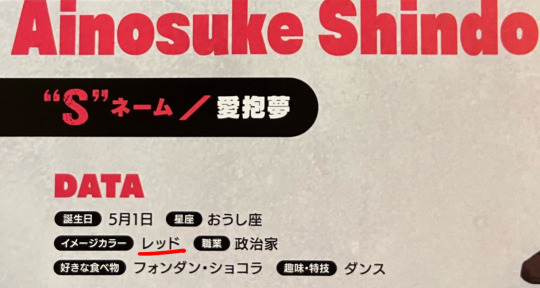
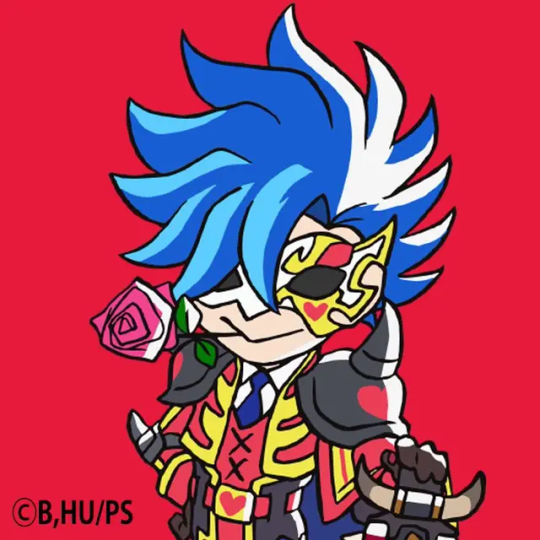
Naturally for the "Matador of Love", Adam's image color is red, a color associated with love, passion and excitement, but also danger and anger, covering both sides of the duality of Adam's connection with love and romance and his violent skating. Utsumi's color notes in SK8 Design Works describe it as "the color of love and blood", and described Adam himself as "a guy who stole a main character's color" - fitting of the fact that in sentai series (and many anime influenced by them,) the red member is almost always the main protagonist and leader. (And perhaps a cheeky reference to Reki, though it seems Adam's color was decided on much earlier on.) Between red and blue being tied for their inclusion in sentai series and yellow in a close second place, the three primary colors form a core trio of characters in sentai series that's also reflected by Reki, Langa and Adam as the three most central characters in SK8.
While many works follow Gorenger's lead with the red protagonist being a hot-headed, passionate natural leader (a role that Adam does command at S as a whole, at least at first,) it's covered such a wide spectrum of protagonists over the course of the genre's history that red's biggest association is simply "being the main character," superseding a single specific character archetype. To momentarily dip into the history of anime itself rather than tokusatsu's influence, I'd be remiss not to mention that thanks to the influence of Mobile Suit Gundam (a franchise that both writer Okouchi and character designer Chiba have history with and mentioned in interviews on Febri as inspiring their interest in anime) it does have a memetic association with speed (and rival characters,) as Gundam's frequently-imitated masked antagonist Char Aznable's custom red mecha is notoriously "three times faster" than any other. (Adam's voice actor, Takehito Koyasu, has even played two "Char Clones" himself.)
As with the other characters, Adam's color appears in the opening but it also surrounds him frequently in the show even from his first appearance, including a red glowing aura to mirror Langa's blue when they're in the Zone (even in the finale when the red is gone from his costume.)
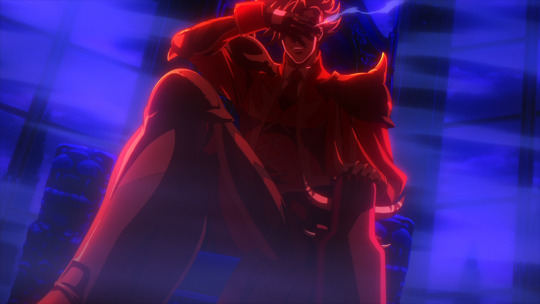
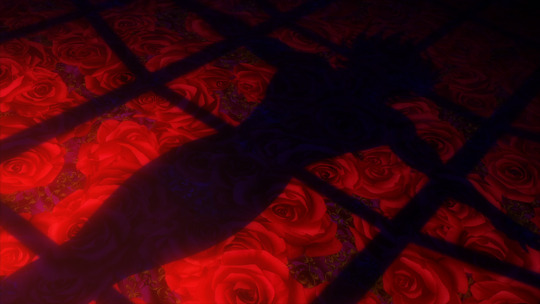
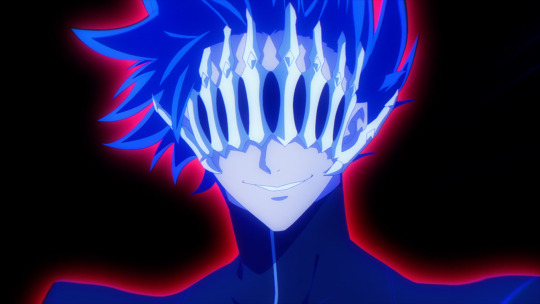
~
Tadashi Kikuchi - Gray
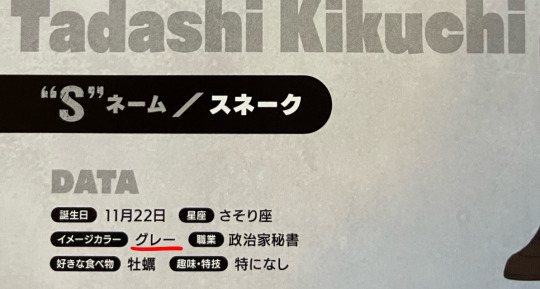
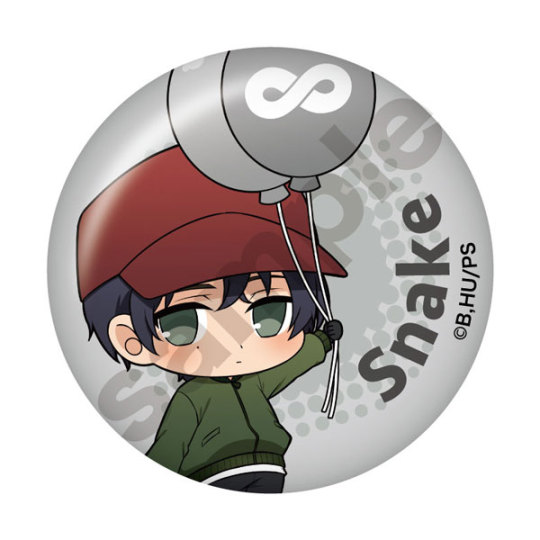
(Tadashi never got an official Twitter icon like the other characters, so I used a different piece of merch.)
Lastly, Tadashi's image color is gray, which is mostly known for being... a bit of a non-color, though it can be associated with gloom, ambiguity or uneasiness. It's mostly seen as a color that blends in and doesn't stand out by itself, which was the purpose behind Tadashi's color scheme, as Utsumi described in her notes as wanting his coloring to "make the main character stand out", given that he was designed from the beginning to appear alongside Adam, who has the "main character's color." Gray is an incredibly rare theme color in sentai series, to the point that there aren't specific character archetypes either; in 2014, at the time of Takahashi's paper, the only gray character she noted was a literal ghost. Even Tadashi's image color is alienated from the other skaters'...
While there are comparatively few (and less obvious) examples of Tadashi's image color appearing in the show, his last emotional scene with Ainosuke takes place in an almost entirely gray room.
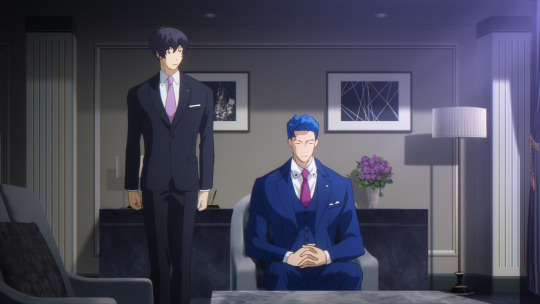
It'll be interesting to see how these associations might continue to be used in the future.
#sk8#sk8 the infinity#meta#sk8 meta#reki kyan#langa hasegawa#miya chinen#hiromi higa#shadow sk8#kaoru sakurayashiki#kojiro nanjo#ainosuke shindo#adam sk8#tadashi kikuchi
73 notes
·
View notes
Text
Becky: Did you hurt yourself? Did you hurt your own body? Can you get home by yourself? Can you get home alone?
Nicky, writhing in pain on the floor: Please help me.
3 notes
·
View notes
Text

i only started this collage last night but am super busy so thought i’d post for his bday. it fits the prompt of Memory & Art for the St. Louis event over at @iwtvfanevents
[edit] As promised, all of the image sources:
The picture of him is from the s2 finale, the frame under him is a stock asset by audiaudi. To his left is Nocturne in Black and Gold, the Falling Rocket (1875) by James Whistler. Above that (graveyard) is from the comic Raptor by Dave McKean, the end paper next to it is from here. Blue stars are by Kiki Smith and that star with the script is by Dina Wakley. Those are the legs of Venus de Milo, the stripes by Sølve Sundsbø, and the “Rock-crystal” is from plate 11 of Chambers Mineralogical Dictionary. Keys are from Handbook of Ornament, 1900. Foil star from Rose Mille, checkers by Harmony Korine, and boy by Ray Turner.
#i have most of the sources for the images used so that will be updated#probablyrambles#my art#digital collage#id in alt text#amc iwtv#wampire linkedin#st. louis of the vieux carré#louis de pointe du lac#iwtvfanevents#i realllllly wanna draw these guys but my brain just isnt working like that rn
31 notes
·
View notes
Text
Emphasis
In Welsh, you can emphasise parts of a sentence by inverting the sentence structure. A common example of this is in introductions!
Helô, shwmae, Bethan dw i! Hello, I'm Bethan! (Mae hynny'n enghraifft, an example, dyw Bethan ddim fy enw)
You'd hardly ever hear "dw i Bethan". The inverted structure introduces and emphasises parts of the sentence. 'Postman' is emphasised here.
Dyma Bob! Postmon newydd yw e. This is Bob! He's the new postman.
"Postmon newydd yw e", rather than "mae fe'n postmon newydd".
Jack yw yn erbyn y mesur, dim Janet. Jack is against the bill, not Janet.
Super Furry Animals yw'r band gorau yn y byd! Super Furry Animals are the best band in the world! (Fight me)
Cymru yw cymhwyso ar gyfer Cwpan Y Byd, dim yr Alban. Wales qualified for the World Cup, not Scotland (mae'n ddrwg 'da fi, ond dim)
It's kind of like using "qui a" in French, really!
In the past tense, use the inflected ending/gwnaeth (gwneud)/roedd (bod) similarly. There's a little a, meaning "that/which/who/whom", again, like the a in french "qui a", that's a bit literary and can be dropped in casual speech
Cymru (a) enillodd y gêm neithiwr, dim Hwngari! Wales won the game last night, not Hungary! Cymru (a) wnaeth ennill y gêm, dim Awstria! Wales won the game, not Austria! Lloegr (a) roedd ennill (tro diwetha i fi wirio...) England were winning (the last time I checked...)
This a is not the same as a/ac meaning 'and'. So even before a vowel like ennill, it remains 'a'.
**I would put a tiny asterisk on the last 2 sentences because I need to check their grammar, the others are fine!
Vocabulary
enghraifft -> an example
enw -> a name
postmon, dyn y post -> postman postfeistres -> postmistress (what's the gender neutral English word for a postman? Post officer?)
bod yn erbyn (rhywbeth) -> to be against (something) gwrthwynebu -> to oppose
cymhwyso (ar gyfer rhywbeth) -> to qualify (for something) ...fel Cwpan Y Byd!
a -> who, whom, which, that
ennill -> to win
gwirio -> to check, verify
#idiomatic expressions#sentences#vocabulary#source: duolingo#source: dictionary#the wondrous Duolingo comment sections are a constant source of extra knowledge; pro tip#dysgu cymraeg#learn Welsh#ONLY TAKE THE VOCAB FROM THIS I am not super sure about the last 2 sentences so really if anyone sees that they're wrong tell me
10 notes
·
View notes
Text
Ateez's Full Storyline Explained - Part 25
Masterlist
Not Okay (Halazia-World)
We're still with Halazia Ateez, though this time we're learning their backstory, specifically the trauma they've experienced at the hands of their own central government before they were woken up
This theme is already made clear from the get go by the opening screen which tells us the dictionary definition of the word "Trauma" before it flashes to a distorted shot of Ateez
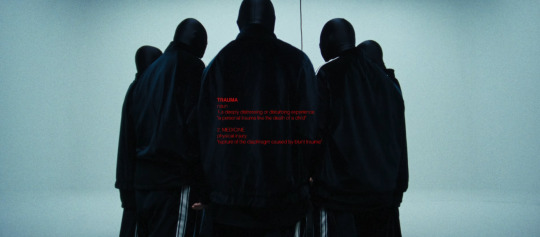
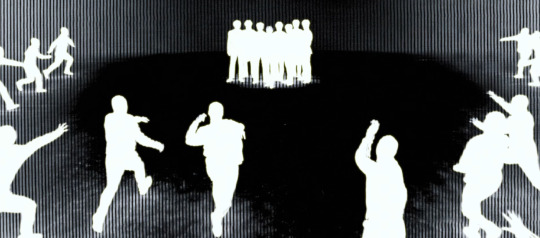
We cut to San running down a hallway, chased by masked people (which is cinematically reminiscent of San running from the guards in Guerrilla) but time doesn't seem to be working the way it should (we'll come back to that later)
We cut to Hongjoong who's in the process of being brainwashed (a method the Z-World central government has also used) with a phone that has been mechanically attached to his hand
On it, we can see, in order, the words: ALONE, MOTHER, LONELINESS, BEHIND (green to white), MISSING, ALONE (green), FAMILY, ALONE (green to white), BEHIND, FAMILY, ALONE, MISSING (white to green), ALONE, AFRAID, MISSING, BEHIND (white to green), MISSING (white to green), ALONE
Much like with the Jongho basketball situation we saw in Everything, it seems like A-World's Hongjoong and this Hongjoong share the same source of trauma: being alone without a family
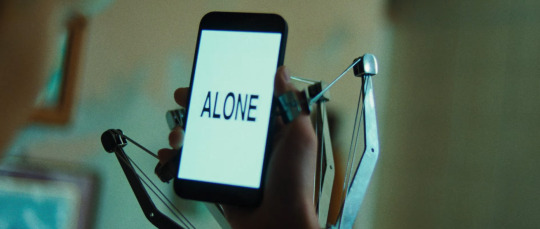
We next join Yeosang and Seonghwa who are being used to test each other's strategic abilities (which is reminiscent of how students are being treated in Z-World)
We see both of them seated at opposite sides of a baduk board in a museum-esque building's foyer while they're being filmed by two production cameras that look like the Canon HD Digi Super 25 xs (does this matter? no. but i looked it up for no reason so now you have to know)
Seonghwa is playing as the black stones and Yeosang as white (as stated by Seonghwa and San in the MV Reaction video) which reflects in their wardrobe
The lyrics make it clear they're being forced to play against each other over and over again
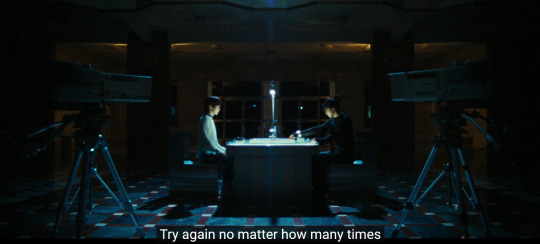

We switch to Yunho who's standing at the top of the stairs in a darkened auditorium. A brief flash of light reveals a figure standing at the bottom of the stairs behind him (we'll get to see who it is shortly)

Wooyoung and Mingi are standing on a small platform surrounded by masked people while the screen behind them shows an audio visualizer, I assume they’re forcing them to record propaganda songs or something, given how we later see them have access to microphones
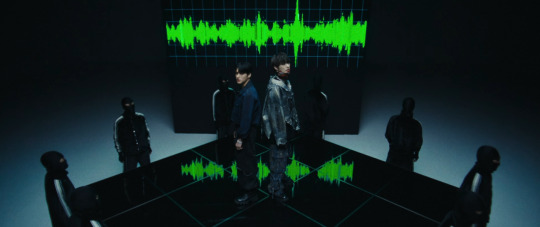
Shortly after, we get a hint of how traumatized San already is when he's alone in the hallway from earlier and already getting flashbacks of being chased by the masked people, trapped in the time loop
The lyrics here state "Fleeting days feel like a mirror image / Are you gonna let it repeat again?", signifying how they're beginning to break free of the victim mindset, ready to take control of their lives and break the cycle
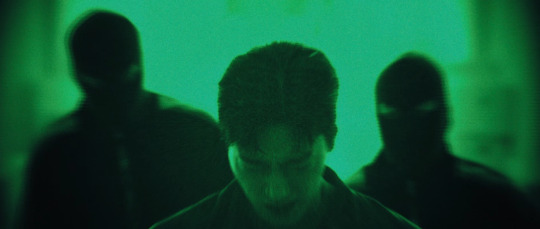
We now return to Yunho in the auditorium where we get some quick shots of multiple versions of him existing within the space while a mysterious hooded person, who we can strongly assume to be his dead brother, is always moving around as well but always just out of Yunho's reach
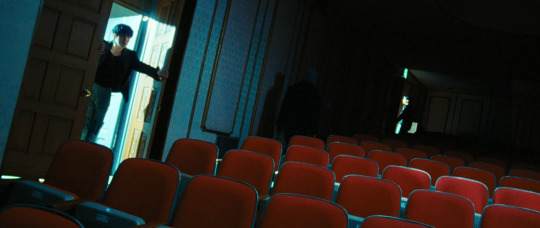

We then get this quick shot of an oncoming car as we transition from Yunho to San which reinforces the parallel to A-World's Yunho whose brother was killed in a car accident (as you may remember)

We also get the caged bird metaphor again for Yeosang which we saw with A-World's Yeosang and which is once again picked up in IT's You
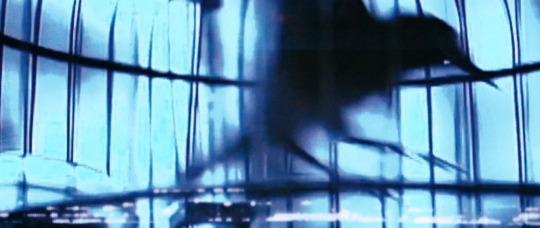
We then get a very clear visual of what they're doing to Jongho - he's on a bed, surrounded by screens where they're actively re-traumatizing and triggering him much like they're doing with Hongjoong
They're showing him video clips of runners, both human and animal, and cars traveling at high speeds which serves as a harsh reminder of his leg injury
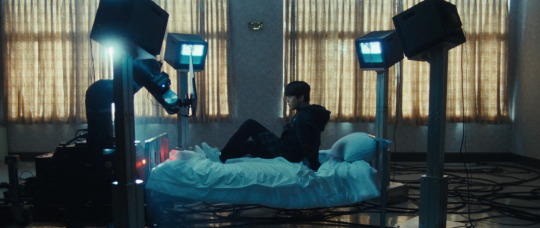
As the screens comes closer to his face, the images begin to flash faster until we get to see his eyes which eventually reflect the words "WAKE UP"
And here is, once again, where my original Halazia theory comes in: this world's Ateez aren't the instigators of the rebellion in their world. Instead, they were awakened by their world's Black Pirates, joined their movement and then took over after the former leaders died.
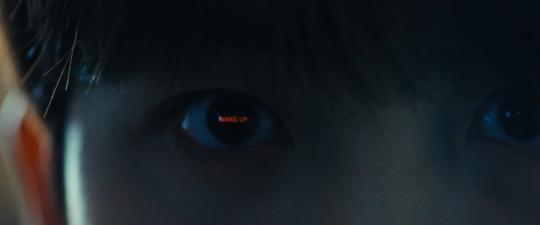
From here, we'll slowly get to see all of Ateez wake up which is also the point where the meaning behind the song's chorus really hits home because this is the first time they're experiencing emotion in at least quite some time and they're confused about their whereabouts, traumatized after all that abuse, and fucking PISSED at the people responsible for all that misery:
This placе, where right and left arе unclear (Make some noise) Feels like a maze (Make some noise) Try again no matter how many times (Make some noise) Nobody can stop us (Make some noise) Raise your voice louder, scream louder Don't be scared and let go, I'm not okay now Roar louder, raise your both your hands and shout You know that I'm not okay
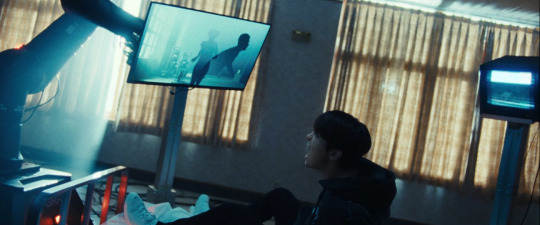
We've now reached the point in the MV where Ateez are beginning to rebel, starting with Jongho screaming, San allowing himself to be captured, and Hongjoong trying to break free of the screen attached to his hand (this also serves as a callout for overexposure to screens, I'm sure)
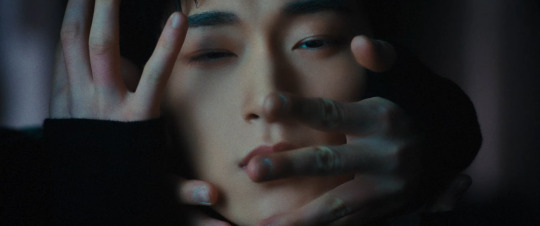
Here, we also get to see the exact moment Hongjoong was awakened: the word "LOVE" gets reflected off his eye right before we cut to Mingi
Their rap verse makes it very clear they're sick and tired of being pushed around and told what to do
Move away, move away, I'm at my limit I can't stand being at someone else's beck and call
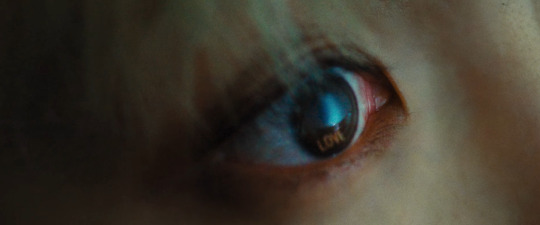
We now move on to the less clear-cut part of the MV: the anomalies
First, we get the giant clock hands on the ceiling in the room Seonghwa and Yeosang were playing baduk in - this references, on one hand, the time loop/cycle they're all trapped in, but on the other hand, could also imply time-travel in the way we've seen before in Ateez lore as the hands are moving much faster than normal - a parallel to the sand flowing upwards in the hourglass when A-World's Ateez first received the Cromer in the Diary Film

We then get the floating smartphones surrounding Hongjoong which are a parallel to the objects floating around Hongjoong in the Diary Film
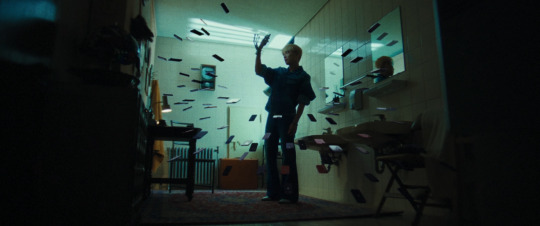
There's a shot of Jongho who's reaching for a mirror version of himself which looks a bit Inception-esque (the movie) after which we get a close up of his face which cracks like glass, implying he fully broke free from the brainwashing and he's justifiably angry
Given all the parallels with Inception and Diary Film, this leads me to assume that, in this world, it's Jongho who received the Cromer in a dream from his alternate self of yet another dimension
This could mean that the Black Pirates in Halazia were originally led by Ateez from yet another dimension but I'm not gonna speculate on that any further until something else hints at it
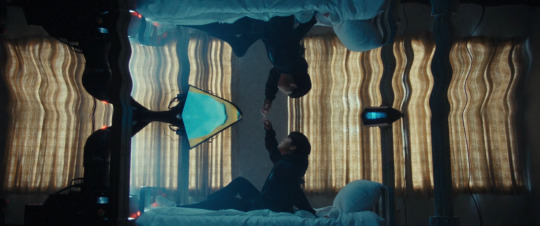
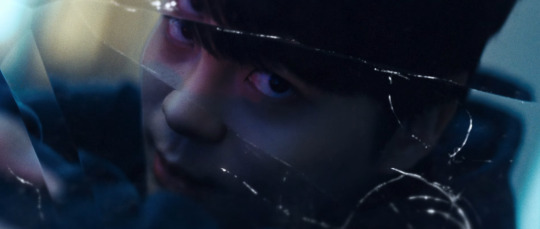
We get shots of San fighting the masked people in the hallway, Wooyoung performing on the stage surrounded by the black-clad people in masks who were already there when he was still with Mingi, and a shot of Yeosang crying
We then get San crawling along the deserted hallway, followed by a shot of an arm wearing a wristband with a small screen that flashes between the words "OBEY, MONEY, DO WORK" before a hand comes in to cover it
These are presumably Yeosang (wearing the band) and Seonghwa (the hand wearing the rings) as they're the ones we see a close up of right after

We next get to see Mingi putting in his earpods which is, once again, a parallel to Diary Film wherein A-World's Mingi would always put them in to listen to music when he needed to distance himself from reality

And we then close on Yunho who's on the stage in the auditorium when he finds the discarded clothes of his older brother. When he lifts them off the ground, bugs come scattering out, making it clear his brother has been long dead and become food for the bugs. Quite macabre.
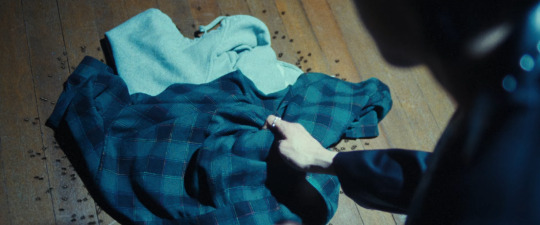
From here, we switch to black and white as this world's Ateez are uniting against the people who've been torturing them which could mean they had to physically fight their way out of the brainwashing facility

Finally, we end on a shot of them together as a united front while the masked people are surrounding them, closing in

95 notes
·
View notes
Note
What are your thoughts on this class division in wizarding society?
What percentage of the population do you believe would be considered upper class? It seems that within the Sacred Twenty-Eight, only families like the Malfoys and Lestranges could truly be considered extremely wealthy. In contrast, the Black family seems more like an example of old money in decline — where their generational wealth was being spent on lavish lifestyle without replenishing their fortune, as suggested by the state of properties like 12 Grimmauld Place, and unlike the Malfoys, they don't seem to own other estates, such as Malfoy Manor.
It's hard to imagine that at least half of pureblood families still belong to the upper class. Most have likely fallen to the middle class, or at best, the upper middle class. This decline in status seems to be the root of their discontent, fueled by a perceived loss of wealth and influence compared to previous generations.
It's likely that purebloods were displaced by half-bloods, who increasingly rose into the upper ranks of society. This shift could explain why so many purebloods were drawn to Voldemort's promises of restoring their power over those of "lesser" blood. They failed to see how their own ambitions would ultimately lead to their downfall.
Hello 👋
I have a lot of thoughts about this and the short of them is:
I don't think blood status has much to do with class because almost everyone is essentially a pureblood and muggleborns and actual half-bloods (with a muggle parent) are in the minority.
I don't think there is a pureblood decline in their society and class isn't really the issue with blood purity, it's just plain ol' bigotry.
I think the Sacred 28 is bullshit and that many purebloods in-universe don't take it all that seriously.
The full essay is under the cut because it got kinda long:
Honestly, I don't think blood status is all that connected with class in the wizarding world, tbh. Like, I talked about this in the first post in this blog, but I think, like, 70% of their population would be considered "pureblood", as in four wizard grandparents. Like, muggleborns are only about 5% of their population, and the majority of the magical population in Britain are ones I won't consider half-blood since technically all their immediate family is magical. So, really, it depends on what you consider "pureblood" and that would depend on how bigoted you are.
The Sacred 28 doesn't include even a third of the families I would consider "pureblood". The Pureblood Dictionary was written by Cantankerous Nott in the 1930s, and this context should be taken into account. He wasn't an unbiased source, and he didn't necessarily even do proper research into the genealogy of families that didn't feel pureblood enough to him (like the name "Potter" sounding too muggle to him) so let's take his writing with a grain of salt. It's also pretty clear families like the Blacks don't see the Sacred 28 as the be all end all since they marry other families which are pureblood but not in the dictionary, like Gamp or Potter, so clearly, many blood purists also take Cantankerous' book with a grain of salt.
Now, I think, since the majority of the population is what I at least would consider purely magical, blood purity doesn't correspond to class. The Weasleys are pureblood, and they are clearly portrayed as poorer and the family seemed to have been lower class for a while. The Prewetts (Molly's family), probably used to be more wealthy but have declined in recent years (from Muriel's behavior, the heirloom tiara, and such, it always seemed to me she was used to a better lifestyle and treatment. Also, Molly's mother was Lucretia Black, giving more evidence to this idea). We saw the Gaunts who were also on the decline in their most recent generations living in a rundown shack.
In the case of the Black family though, I don't think they were in that bad of a state. They clearly had money, I mean, buying the super expensive Firebolt didn't make a dent in Sirius' inheritance that he kept living off of. And they clearly lived in luxury before all the family died out, so I don't think they were that much on the decline. They probably weren't at the peek of their wealth, but they were far from struggling.
I think the state of Grimmauld Place has more to do with Walburga's and Kreacher's mental health rather than money problems. Also, I wouldn't say they don't have any other houses, we don't actually know that. Personally, I always read it as Sirius and Regulus clearly not growing up in the same house as the Black sisters, so I assume there are other houses that at least belonged to the Black family. Let's not forget that until a generation ago, there were quite a few of them around.
And, yeah, sure, the Potters are new money rich (from Sleekezyes) and aren't sacred 28, but the Potters are an old enough pureblood family the Blacks didn't disown Dorea for marrying into. This suggests that they are seen, in universe, as very much an old and established pureblood family in the UK and that the reason they aren't in the sacred 28 is Cantankerous Nott bias. So, again, the Potters aren't an example of half-bloods becoming more relevant or purebloods being on the decline.
The Crouchs are part of the sacred 28 and are clearly wealthy since they have a house elf, which is expensive and a sign of prestige:
“Well, whoever owns him will be an old wizarding family, and they’ll be rich,” said Fred. “Yeah, Mum’s always wishing we had a house-elf to do the ironing,” said George.
(CoS)
Also, the fact Crouch had incredibly influential ministry positions before and after the scandal with his son (you need to be very rich and very well connected to remain a department head after that at all, even if it is a less prestigious department).
The Malfoys are sacred 28 and are clearly very rich. We know they made most of their money from land they got in the Norman conquest and later muggle dealings, so that money is old. But we don't see them in decline until Voldemort returns. Lucius is living his best life, throwing away money on brooms for the Slytherin team, sitting on the board of governors, and having the minister's ear. Clearly, purebloods who had influence didn't all lose it.
The Smith family descends from Helga Hufflepuff, they are clearly pureblood but they aren't sacred 28 (name is too muggle). We also know they are pretty rich, both from Zacharias' behavior and from the fact Hepzibah Smith owned a house elf.
Parkinson, Crabbe, and Goyle (only the Parkinsons are Sacred 28 but Crabbes and Goyles are clearly pureblood as well) are likely living very comfortably, but they're not as wealthy as the Malfoys or Blacks. As Pravati seems to know at least Pansy from before school:
“Shut up, Malfoy,” snapped Parvati Patil. “Ooh, sticking up for Longbottom?” said Pansy Parkinson, a hard-faced Slytherin girl. “Never thought you’d like fat little crybabies, Parvati.”
(PS)
I assume the Patils are seen as pureblood (even if they aren't on the sacred 28) and have about the same level of money as the Parkinsons do. I mean, I don't see Pansy’s parents being friendly with someone who isn't pure enough for their standards.
So, I don't think class is inherently tied to blood status since, as I said, most of the population is essentially pureblood, and it won't make sense for all the population to be rich aristocrats, that's not how this works. I also don't think there is necessarily a pureblood "decline" that created the antagonism towards muggleborns, most rich and influential characters we see are pureblood or essentially pureblood since they were raised by wizard parents in the wizarding world. I also think the tension around blood status is way less justifiable. Like, I don't think it has a good reason like that — it's just bigotry, and it has existed for centuries. It ain't new.
We see blood purist purebloods, or half-bloods reach very high positions in the ministry. It's muggleborns who seem to be struggling to get offers for ministry positions since they don't know anyone who could pull them in (since the ministry runs on connections, which is where the Slug Club comes in for talented muggleborns). In both wars with Voldemort, the ministry was Death Eaters. Many Death Eaters or other blood purists already had high ministry positions, just waiting for Voldemort to take over and let them do what they wanted with them: Lucius, Umbridge, Yaxley, Rookwood (in the first war), Runcorn, and many more since we don't have all the names.
In the first war, Arthur said it was 20:1:
Oh, Molly, come on, it’s about time you got used to hearing it — look, I can’t promise no one’s going to get hurt, nobody can promise that, but we’re much better off than we were last time, you weren’t in the Order then, you don’t understand, last time we were outnumbered twenty to one by the Death Eaters and they were picking us off one by one...”
(OotP)
As the first Order had 22 members in the photo Moody showed Harry, that would place the estimated number of Death Eaters at 440 (or more), which is an insane number to their measly population size of max 7,000 and would explain why the Death Eaters range multiple classes of wealth considering the sheer amount of members and sympathizers.
The reason the Death Eaters could take over so easily twice was because they had their own people in key positions. Don't get me wrong, I don't think the Carrows or Macnairs are particularly wealthy or influential, but they aren't suffering either. It's not that muggleborns took their status and positions. They didn't. There are very few muggleborns in the ministry (and in their population as a whole). And actual half-bloods who have a muggle parent are a minority as well. I'd estimate up to 90% of wizards grew up in the wizarding world with wizard parents. (Tonks is considered a half-blood, but her father is a muggleborn; he's a wizard, and she grew up in the wizarding world, so she barely counts as a half-blood as she lived around magic all her life). So, I don't think the tension about blood status comes from any fear for their traditions or lifestyles or their status being taken away by half-bloods — because I don't think anything like that is happening. Not really.
We even see muggleborns like Hermione choose to assimilate, embrace everything the wizarding world is, and forsake their muggle upbringing, which is likely something Ted Tonks did as well. It's not purebloods who have their lifestyles change, it's muggleborns who assimilate into the new world they enter. It's why Hermione learns and reads as much as she does, it's why past the first year she quietly stops mentioning her muggle parents and spends less and less time in the muggle world.
I do want to note, regarding class, that all wizards do go to the same school, so wealth and class clearly don't register to them the same way they do to us. I think it's less cut and dry for them because of how small the population is.
Like, if you want to marry only wizards, you have like 6,200-7,000 max people in the population. Looking at only those around your age, it would bring you down to like 400, maybe 500 wizards/witches. Cut that in half since you're probably gonna be looking for a het match, so you have 200-250 candidates. Let's say you're a blood supremacist so we remove all muggleborns and half-bloods from the list, and we're down to about 140. Remove families of blood traitors or ones you can't be with because they're too closely related to you, and you're down to less than 100 probably. And then, if you cut this down more by class and wealth, purebloods would have an even smaller possible genetic pool. And most of them don't want to end up like the Gaunts, they know marrying too close is a bad thing. In the Black family tree, the only close marriage we see is between Orion and Walburga and they were second cousins, which isn't that genetically close. So I think there is quite a lot of movement between classes and that most families are way less concerned about class than about blood.
To summarise, I see class in the wizarding world as not super strict and there is quite a bit of movement. As most wizards are wizard-raised, blood status doesn't matter to wealth or class all that much and you see old money and newer money working together (Lucius and Fudge) along with poorer people of similar blood status working with them (Macnair and the Carrows).
(I always got the vibe from Macnair he is lower middle class at most: “Macnair . . . destroying dangerous beasts for the Ministry of Magic now, Wormtail tells me? You shall have better victims than that soon, Macnair. Lord Voldemort will provide. ...”, and the Carrows aren't giving aristocrat vibes either)
Like irl, there are a lot of variations. You have old families who were always well off but not extremely rich until recently (Potter) you have old money that's still living and kicking (Malfoy, Crouch), you have old money in decline (Prewett and Gaunt, to a more extreme degree), and you have rich families (although less than the Malfoys) with really shitty luck where the money is still there but there's no family to use it (Black). We also have poor families (like the Weasleys. Also Umbridge's family was quite poor, it was a half-blood family, btw, since her mother was a muggle).
The majority of wizards probably fall into the range in between — the middle class. With some on the upper end of this scale (Parkinson, Patil, Longbottom) and some on the lower end (Macnair, Carrows). Characters like Seamus and Lavender are also clearly somewhere comfortable in the middle class. Slughorn is another Sacred 28 name and the man seems used to spending and luxury, but he isn't extremely rich either, so I usually place him in the upper end of the middle class.
Additionally, the Pureblood Dictionary (where the sacred 28 are from) is bullshit and most pureblood families don't treat it as the end all be all, but more as a useful resource along with other resources. (my headcanon is that Cantankerous Nott wrote it to assure everyone of his own blood purity. JKR said in the past the Notts are as pureblood as the Malfoys, and we know the Malfoys have married muggles in the past... so...)
So, yeah... these are my thoughts, it's not all that organized, but I hope it makes sense.
#harry potter#hp#hp meta#harry potter meta#asks#anonymous#hollowedtheory#wizarding world#wizarding society#blood purity#hollowedrambling
20 notes
·
View notes
Note
Is there a way for me to figure out speech & expressions in a specific past century? I've been trying to write a novel set in the 16th century but there are alot of expressions & idioms that I don't know if they existed back then or not. Do I just cut them out completely?
Researching Historical Lingo, Slang, and Grammar
Here are some things you can do to research the proper lingo, slang, and grammar for a historical setting:
1 - Google "slang (or phrases, lingo, grammar) of [era/decade] [location]" - I don't know where your story is set, but as an example, I Googled "slang of 16th century England" and got back 13 million hits, including things like "9 Elizabethan Words to Bring Back," "English Slang 1400 To 1680," "Elizabethan Swearing, Cursing and Vocabulary" and others. If you Google the era/decade and location of your story and take the time to sift through the results, you can get to know the lingo, phrases, slang, and grammar that would make sense in your story. (Just remember not to over rely on it... you want to avoid obviously modern phrases or words... no one in Elizabethan England would call something "freakin' sweet"... but you also don't want to write something so archaic sounding that it annoys the reader.)
2 - Go to YouTube and Search "slang (or phrases, lingo, grammar) of [era/decade] [location]" - YouTube can be a great source for learning how people spoke in a particular time and place. And in video format, this information is usually presented with additional information about the people and place that helps you understand why they spoke the way they did.
3 - Look for Books About Your Time Period and Setting - There are a lot of time/place settings that are popular enough to have books written about them. There's no shortage of books dedicated to life in Tudor and Elizabethan England, for example, and there are books dedicated to writing stories set in that time and place as well. Whether you go to your local library and ask, go to a local bookstore, or look on Amazon, books about your setting and time period can be a really helpful resource for learning about how people spoke.
4 - When In Doubt, Ask Google - If there's a particular expression, idiom, slang, or lingo you want to use but you're not sure if it existed in your story's time and place, try Googling the phrase plus "origin" or "etymology." That will almost always bring up something that will tell you the history of the expression, idiom, slang, or word that you're curious about. For example, let's say I wanted to know if they would have said "right as rain" in Tudor England. The very first hit on Google told me that while "right as rain" did originate in England, it doesn't seem to go further back than the 1800s. So, it wouldn't make sense for my Tudor character to say it. Some articles will suggest earlier variations, too, which can give you a fitting alternative. @definitely-not-julio suggested the OneLook online thesaurus which has an origin tab... and that actually leads to the Online Etymology Dictionary, which is a fantastic resource.
You can also use any number of idiom search engines or the dictionary to learn the origin of a particular phrase or word.
5 - Curl Up and Watch Stuff - One last helpful resource I want to mention is the great and powerful screen, whether that's the TV screen or device screen. There's a whole world of period dramas out there that take place in just about every possible time and place, so if all else fails, try watching a TV series or some movies set in the time and place of your story, and take notes! Just be aware that TV and movies aren't always super accurate, so it's a good idea to still double check anything you use, but they can be a great way to learn all kinds of potential words, phrases, lingo, etc. The Willow and Thatch web site has a list of period dramas by era (click on "best period dramas list") and it also has lists of period dramas by streaming service.
Have fun researching your story!
•••••••••••••••••••••••••••••••••
I’ve been writing seriously for over 30 years and love to share what I’ve learned. Have a writing question? My inbox is always open!
Learn more about WQA
Visit my Master List of Top Posts
Go to ko-fi.com/wqa to buy me coffee or see my commissions
412 notes
·
View notes